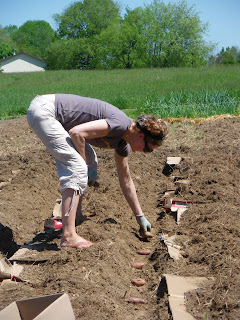Quite often people think why bother to grow your own potatoes when they can be purchased so cheaply at the grocery store in August. But for me there's no comparison. The grocery store choices tend to be restricted to Kenebec, Chieftan, Yukon Gold (or even identified only as red, white and yellow). There are so many heirloom and newly developed potatoes in all kinds of colours and shapes - some best for frying, others for baking, different ones best suited to boiling and then the ones like Yukon Gold described as "all purpose".
Additionally there is the issue of pesticides and herbicides. In conventional commercial farming potatoes have a heavier spraying schedule than any other vegetable and all that stuff is taken right down into the tuber we eat.
But I must admit I have spent a disproportionate amount of my life picking potato bugs. Normally I have planted potatoes on the weekend of Mother's Day but this year I delayed it a couple of weeks. I have heard from more than one source that delaying the planting could miss the first cycle of potato bugs so it seemed serendipitous that the newly tilled field wasn't ready to be planted in early May.
Before planting I wanted to lay down black landscape fabric on the new bed in the field where the potatoes are destined to go. All the tilled weeds will add fertility if they break down but until then every tiny bit is a potential new weed plant. I hoped that the black tarp would smother or fry at least some of the weeds. Later the potatoes themselves should help clean out the bed. Between hoeing between the hills as the potato foliage grows, spreading cardboard between the rows and adding fall leaves I have been storing in the garage, the plan is that by the time the potatoes have been harvested the soil will have much more fertility and way fewer weeds! (But of course I don't need to be reminded of the "best-laid plans"!)
 |
| Black landscape fabric on part of the new bed |
The first step in planting potatoes is to lay out the seed potatoes. Inside the house they get at least some light for about a week and aren't too cold.
 |
| Seed potatoes laid out to green sprout |
Dark Red Norlands and French Fingerlings went on the counter on May 12. A week later the sprouts have turned green and they're ready to plant.
 |
| Dark Red Norlands with sprouts that have greened up |
Diane helped me plant them. We dug trenches and laid cardboard between them. After we laid the potatoes in the trenches we hoed just enough soil to cover them. I checked them the next day to throw a little extra soil on any that were exposed.
 |
| Diane hoeing the trenches with a "mulch" of cardboard |
 |
| Laying out the French Fingerlings |
 |
| Banana potatoes after a week on the counter |


















